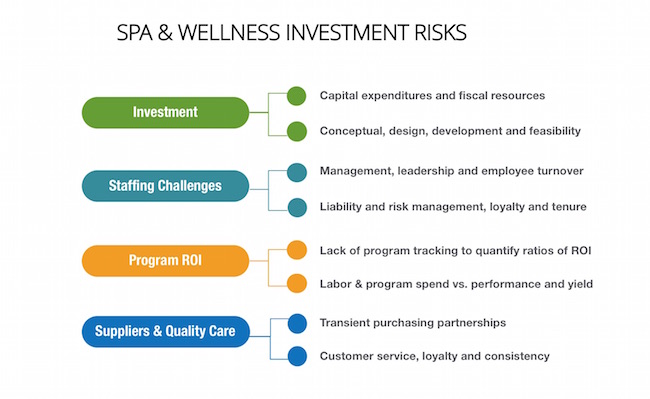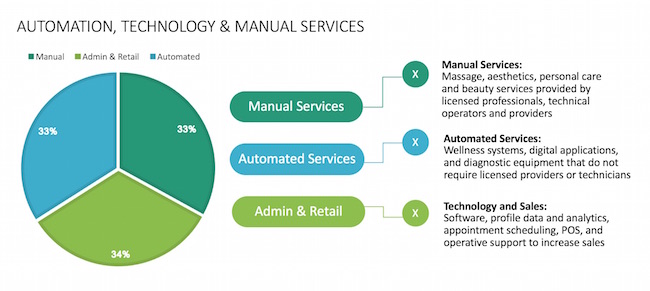By Mia A. Mackman
Spa and Wellness program structures fall into a wide range of performance categories and operating models. For hotels, there are multiple applications that include combinations of relaxation, well-being and treatment-based sessions. While some of the newest and popular trends include features centered on health and lifestyle; there are often wide gaps between drive, delivery, and financial return. Having an acute understanding of how spa and wellness features intersect with perceived value and profitability percentages, conveys important impacts on asset performance, momentum and risk.
Spa and Wellness structures that deliver long-term value and execute well are shaped commonly by three things successful integration, economic performance and a core company mission. It's common to see activities like yoga, mindfulness meditation and forest bathing in the wellness fold. However, understanding how these activities contribute to the total revenue ratios of the property is key to increasing RevPAR and fostering a preeminent and thorough return on investment. It's also pertinent to understand the demographics, customer profile and central selling points of the hotel or resort.
Conceptual Planning and Development
Wellness focused development is generating intense pursuits throughout the hospitality sector. There are a multitude of innovative design styles, new concepts, healthy building, and restorative developments underway worldwide. In the past, simple floor planning and designs were fixed components of a new build. Today, floor planning has become more fluid and organizing design components with a sense of flexibility and freedom is a beneficial advantage. Creating infrastructures that accommodate program changes, fluctuations in guest flow cycles, and future growth can help support spatial alterations and facilitate productive engagement.
Understanding what the needs of the property are in tandem with the goals it has for growth, can help tailor essential design segments. This can effectively mark conceptual ideals that fit appropriately or clash with the scope of development and square footage per return on investment. For example, designing spa and wellness spaces with distinct singularities or non-negotiable room allocations, can be counterproductive. This applies to utilities, fixtures, the use of rooms as well as wall density and the overall layout and theme.
Concepts that which are tied too tightly to fleeting trends can become a liability. Whereas, general wellness themes that maintain a sense of agility can foster more security, customization and yield stronger outcomes. For example, a spa that offers full-service treatments based on sensational verve is likely to lack the depth necessary to diversify and readily advance extended services. Choosing to modify or expand services from existing systems built on fundamentals leaves room for higher levels of education, innovative add-on services and program flexibility.
Since, hotels and resorts are unique, challenges vary as well. Figure 1, illustrates four of the leading spa and wellness investment risk categories that are commonly associated with revenue, profitability and return on investment.
Spa & Wellness Investment Risks
Source: Mia A. Mackman
Innovation and Risk
Brilliant lineups of new technology and automation are making way for spectacular new spa and wellness additions with rewarding returns on investment. Many of these new offerings do not require hands-on providers to engage the value of these services. In a previous article I wrote for HBR, Reorganizing Spa Operations to Leverage Automation and Technolog, I highlighted the benefits of featuring a new operational paradigm to offset labor costs and increase financial performance while protecting various facets of investment. That article expresses the importance of integrating new systematizations to stimulate and streamline profitability by retooling the focus from manual services and embracing technologies to support profitability and growth.
As increasing awareness has been brought to issues surrounding sexual harassment, assault and misconduct in light of the Massage Envy lawsuits. This has resulted in the process of hiring and screening to gain aggregated importance. Whereas, the urgency to be proactive when it comes to risk management and professional liability have taken a new tone of urgency. Addressing these issues thoroughly as a part of the early hiring process can help ward off unnecessary threats. Thereby, afterwards enacting proactive follow up by offering comprehensive employee intervention, risk management programs or mandatory employee webinars and education.
There will always a reasonable measure of risk when it comes to personal services like massage, body treatments, aesthetics, and so on. The recent spotlight on Massage Envy only conveys the obligation and need to enact stronger policies and procedures, clarify employee guidelines and define client etiquette expectations. With systems in place to manage potential interaction issues this makes way for effective protocols, without evasion or delay. Adding clarity to guide conduct anticipations for both employees and guests, will impart increased professionalism and help reduce the opportunities and risks for inappropriate behavior.
Operational Flow
Some of the most significant challenges properties face are management, leadership and employee turnover. Leadership is the primary driver that nurtures any successful business. And the spa and wellness workforce are a unique pool of highly-individualistic, creative and empathic workers. There are a number of uncommon factors that affect the conditions and resiliency of their daily grind. Approximately, 65% of Spas choose to outsource their management to Spa Management Companies. While this option may appeal to owners and stakeholders, outside management without in-depth performance oversight can create a series of challenging risks and compromise employee stability, financial return, quality of service and overall asset value.
Finding quality and committed staff is further challenging, in light of widespread spa and wellness workforce shortages. This creates its own wrinkles in the hiring and advancement process and evokes competitive hiring packages to win employee favor. For example, benefits, bonus' and opportunities for advancement, add substance to any potential new professional prospect. Meanwhile, “it is estimated to cost more than twice an employee's salary to find and train a replacement. At that rate, most spas can't afford to lose an employee but turnover rates in the spa industry are alarmingly high.”
Going the extra mile for well-performing staff members helps reinforce their value to the business. These investments are always worthwhile. Whereas, extending various types of rewards and recognition for performance and hard work, can be precious expressions of appreciation. This can help alleviate anxiety and curtail discontent employee attitudes. Moreover, supporting employee satisfaction and significance can also greatly improve the quality of customer care and service in addition to amassing a longer-lasting employee duration and improving workplace culture.
Automation, Technology & Manual Services
Source: Mia A. Mackman
Product and Retail
When it comes to choosing retail products and key suppliers, it's vital to build relationships that enhance the business and support long-range growth. Many times, there are significant changes made to inventory and retail purchasing when there is a transition of leadership. This represents a detrimental trend for owners, stakeholders, employees, and guests in a number of ways. While some purchasing choices may be led by the influx of a Spa Director, incorporating a steadfast collection of products through long-standing supplier relationships can have powerful results, stabilize costs, protect investment benefits and facilitate higher returns.
For example, leadership cycles that changeover every 24-36 months, with significant inventory rotations, naturally become a risk that threatens product engagement, sales revenue and consistency. Whereas, retail can generate approximately 30% or more of a spas gross revenue, this trend deserves serious consideration and review. While some degree of product rotation can be healthy-change, supplies like equipment, linens and back of the house items, should be maintained through a long-term advantage of choice suppliers. This further reinforces the importance of tenure and trust.
In the case whereas there are multiple purchasing and leadership changes within a 5-year period, the investment per aggravated expense, often results in transient returns. Regulating product purchasing can help create more consistency, form stronger vendor relationships and control mislaid revenue. It's also helpful to choose suppliers who provide excellent product support, regular education and marketing resources, to facilitate greater stability and sales. This shifts procurement from whims and trends
New Systems and Safeguards
Managing investment risks can start from conception and development complete to long-term performance. Conducting a return on investment analysis with the proper systems in place to digest the trajectory of supposed value, management and financial performance, can set up safeguards to forewarn against low performing revenue segments. Issues like leadership, employee assurance and tenure can also greatly reduce or increase levels of investment risk.
Establishing new procedures to track and manage cost-effectiveness can be done in a variety of ways. Moreover, the move to increase efficiency through diligent planning in the early stages will help protect the business navigate poor investment possibilities; that can lead to unexpected, and preventable lost revenue.
Final Thoughts
Understanding potential risks when it comes to making initial and ongoing spa and wellness investments, holds distinct advantages. This process requires objectivity, with a distinct and comprehensive view on program feasibility and profitability forecasting. Any program or investment that lacks principal management and oversight can become placed at risk for performance. Some of the most effective ways to mitigate against risk, include setting up systems that support the holistic success of the business. These procedures can significantly moderate risks, inspire stronger employee attitudes and cultivate proactive quality and care.
This article is reprinted from the Hotel Business Review with permission from www.HotelExecutive.com



